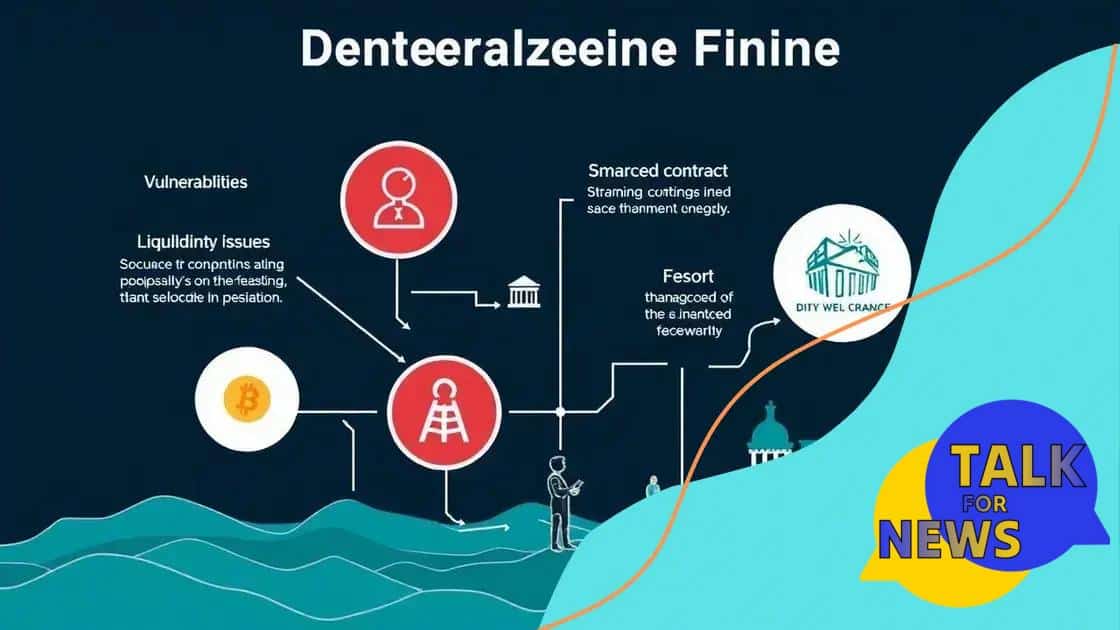Decentralized finance (DeFi) disrupting traditional banking

Anúncios
Decentralized finance (DeFi) revolutionizes banking by providing open access to financial services, enhancing efficiency, and enabling innovative products without intermediaries, empowering users globally.
Decentralized finance (DeFi) is changing the way we think about banking. Imagine a world where financial services are accessible to everyone, without the need for traditional banks. Curious about how this affects your financial future?
Anúncios
Understanding decentralized finance (DeFi)
Understanding decentralized finance (DeFi) is crucial in today’s evolving financial landscape. This financial revolution leverages blockchain technology to provide financial services without traditional banks. As DeFi continues to grow, it changes how we think about banking.
One major aspect of DeFi is its accessibility. Unlike traditional finance, which often requires intermediaries, DeFi platforms allow users to engage directly with each other. This means that anyone with an internet connection can access lending, borrowing, and trading services.
The principles of DeFi
Anúncios
There are several key principles that define decentralized finance.
- Transparency: All transactions are recorded on a public ledger.
- Security: DeFi utilizes smart contracts to automate processes and reduce risks.
- Interoperability: DeFi platforms can work together, allowing users to move assets easily.
- Permissionless access: Users can access DeFi services without needing approval from a bank.
This decentralized framework not only empowers individuals but also promotes innovation. For instance, projects can experiment with new financial products without regulatory barriers associated with traditional finance. Users can now enjoy features like liquidity mining and yield farming that were previously unimaginable.
However, understanding how to navigate DeFi is important. Familiarizing yourself with different platforms and their functionalities can help avoid pitfalls. While opportunities abound, risks such as volatility and security vulnerabilities exist. It’s wise to approach this new landscape with caution and educate oneself regularly.
Common DeFi applications
Some popular applications of DeFi include:
- Decentralized exchanges (DEXs): These platforms allow trading without a central authority.
- Stablecoins: Cryptocurrencies pegged to stable assets like the US dollar.
- Lending platforms: Users can earn interest on their crypto holdings.
- Insurance: Decentralized insurance protocols offer coverage against specific risks.
As the DeFi ecosystem continues to mature, it presents exciting possibilities for the average user. The potential for financial autonomy and innovation is greater than ever. Keeping up with trends and developments will be essential for navigating this dynamic landscape effectively.
Key benefits of DeFi over traditional banking
The key benefits of DeFi over traditional banking are transforming how we manage our finances. DeFi offers more than just convenience; it reshapes the entire landscape of financial transactions. By eliminating intermediaries, it reduces costs and increases efficiency.
One of the most appealing aspects is the potential for higher returns. In DeFi, users can earn better interest rates through decentralized lending and yield farming compared to standard savings accounts in banks. This can lead to increased wealth over time, as individuals can put their assets to work more effectively.
Enhanced accessibility
Decentralized finance platforms are open to anyone with an internet connection. This removes barriers that often exclude people in underserved communities from accessing financial services. Instead of being limited by geographic location or banking relationships, users can participate in a global financial system.
- No minimum balances: Many traditional banks require minimum balances to avoid fees.
- Global access: Anyone can participate in DeFi, regardless of their location.
- Low fees: Transactions often have lower fees compared to traditional banking.
Moreover, DeFi provides users with full control over their funds. In contrast, traditional banks hold your money, and access can be restricted. With DeFi, users maintain ownership through private keys. This grants users the freedom to manage their assets without the risk of bank closures or restrictions on withdrawals.
Innovative financial products
The innovation inherent in DeFi is another significant advantage. Users can explore diverse products that aren’t available in traditional banks, such as decentralized exchanges for trading, synthetic assets, and unique lending protocols. Each of these products opens new doors for financial strategies.
Furthermore, transparency is a vital benefit of DeFi. All transactions occur on a public ledger, allowing users to track and verify their activities without concern for hidden fees or deceptive practices. This level of visibility builds trust among participants.
Security also plays a crucial role in the appeal of DeFi. While no system is entirely free from risk, many DeFi protocols employ advanced cryptographic techniques and audits to secure user funds. This enhanced security can decrease the chances of fraud compared to conventional banking systems.
Risks associated with decentralized finance

While decentralized finance (DeFi) offers many advantages, it also comes with significant risks that users should be aware of. Navigating this new financial landscape requires understanding both the potential rewards and the dangers involved.
One major risk is volatility. The prices of cryptocurrencies can swing dramatically, leading to substantial gains or losses. Users must be prepared for the fluctuations that are common in the DeFi space, making it critical to manage their investments wisely.
Smart contract vulnerabilities
Another important concern is the risk of smart contract vulnerabilities. These contracts are pieces of code that execute transactions, and any bugs or flaws can be exploited by malicious actors. If a smart contract is compromised, it can lead to loss of funds for users.
- Audits matter: Proper auditing can help identify vulnerabilities before they are exploited.
- Stay informed: Users should research the platforms they engage with and understand their risk levels.
- Diversification: Spread investments across different DeFi projects to mitigate risks.
An additional risk involves liquidity issues. In some DeFi platforms, there may be low liquidity, causing problems when users try to withdraw or trade their assets. This can lead to slippage, where the price changes unfavorably during a transaction.
Regulatory uncertainty
Regulatory uncertainty is another point of concern. Governments around the world are still trying to determine how to regulate DeFi, and changes in legislation can impact the value and legality of certain projects. Users may potentially face legal repercussions if they engage with platforms that come under scrutiny.
Additionally, as DeFi grows, so does the risk of scams. Phishing attacks and rug pulls—where developers abandon a project, taking investors’ money—can occur more frequently in the DeFi space. Therefore, users should conduct thorough research before investing and remain vigilant.
The complexity of DeFi products can also be a risk factor. Many users might not fully understand the tools and assets they are using, which can lead to poor investment decisions. It is essential to take the time to learn about the products offered and how they work.
Real-world applications of DeFi
Real-world applications of decentralized finance (DeFi) are rapidly transforming various sectors. These applications demonstrate how blockchain technology can enhance financial transactions, increase efficiency, and offer new opportunities to individuals and businesses alike.
One prominent application of DeFi is in lending and borrowing. Platforms like Aave and Compound allow users to lend their cryptocurrency and earn interest. Borrowers can take out loans without traditional credit checks. This opens up access to financial services for individuals who might not qualify for bank loans.
Decentralized exchanges
Decentralized exchanges (DEXs) such as Uniswap and SushiSwap enable users to trade cryptocurrencies directly. This is different from centralized exchanges, where transactions occur through an intermediary. Using DEXs minimizes the risk of hacks and allows for greater control over funds.
- Liquidity pools: Users can provide liquidity and earn fees from transactions.
- Yield farming: Many users earn rewards by staking their assets in liquidity pools.
- Token swaps: Users can easily swap one cryptocurrency for another without intermediaries.
Another practical application of DeFi is in the creation of stablecoins. These cryptocurrencies are pegged to real-world assets, such as the U.S. dollar. Examples include USDC and DAI, which provide stability and can be used for transactions and hedging against market volatility.
Insurance solutions
DeFi is also breaking new ground in the insurance sector. Traditional insurance often involves complex processes and paperwork. However, decentralized insurance protocols like Nexus Mutual utilize smart contracts to offer coverage transparently. This approach simplifies the claims process and increases trust.
Furthermore, DeFi is making its mark in the investment landscape. Users can invest in various DeFi projects directly through Initial DEX Offerings (IDOs). IDOs allow projects to raise funds from investors while providing early access to new tokens.
The use of DeFi in remittances is another growing trend. People can send money across borders faster and cheaper without relying on traditional financial institutions. This is particularly beneficial for individuals in developing countries who have limited access to banking services.
The future of DeFi and banking
The future of decentralized finance (DeFi) and banking is an exciting and evolving topic. As technology advances, the relationship between traditional banking and DeFi is expected to change drastically. This shift could lead to a more inclusive and efficient financial system.
One of the key areas to watch is the potential for collaboration between decentralized finance and traditional banks. Many banks are exploring ways to integrate blockchain technology into their operations. By leveraging this technology, banks can enhance their services, streamline processes, and offer better products to customers.
The rise of central bank digital currencies (CBDCs)
Central banks around the world are also considering how to issue their own digital currencies, known as CBDCs. These currencies could coexist with existing cryptocurrencies and help formalize the use of digital assets. CBDCs could provide stability and trust, which are essential for mass adoption.
- Improved payment systems: CBDCs can offer faster and cheaper transactions.
- Financial inclusion: They can enhance access to financial services for unbanked populations.
- Better monetary policy: Central banks could have more control over the economy through CBDCs.
Another significant aspect is the implementation of regulatory frameworks. As DeFi continues to grow, regulators are paying closer attention. Establishing clear guidelines will help protect consumers while fostering innovation. A balanced regulatory environment can enable both DeFi and traditional banking to thrive together.
Innovative financial products
The future of DeFi will likely see the development of more advanced financial products. These could provide users with unique investment opportunities and risk management tools. As more participants enter the DeFi space, demand for sophisticated solutions will grow.
Additionally, the integration of artificial intelligence and machine learning will play a crucial role in the future of decentralized finance. These technologies can help analyze data, predict market trends, and automate processes, leading to a more efficient and responsive financial ecosystem.
As we look ahead, community-driven governance in DeFi projects is also expected to evolve. Users will have a more significant say in the development and direction of projects. This democratization of finance can lead to transparency and a greater sense of ownership among participants.
FAQ – Frequently Asked Questions about Decentralized Finance (DeFi)
What is decentralized finance (DeFi)?
DeFi refers to a financial system built on blockchain technology that allows users to perform transactions without traditional banks as intermediaries.
How does DeFi enhance accessibility to financial services?
DeFi platforms are open to anyone with an internet connection, allowing individuals around the world, especially those underserved by banks, to access financial services.
What are some risks associated with DeFi?
Risks include market volatility, smart contract vulnerabilities, and potential scams. Users should understand these risks before participating.
How can traditional banks benefit from DeFi?
Traditional banks can collaborate with DeFi platforms to offer improved services, innovative products, and faster transactions, ultimately enhancing customer experience.





